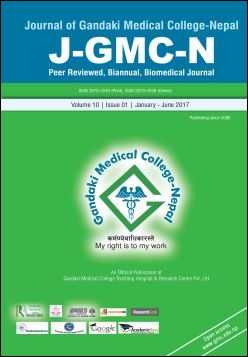Sonographic Measurement of Spleen in Relation to Age: A Prospective Study among Adult Nepalese People in Western Nepal
DOI:
https://doi.org/10.3126/jgmcn.v10i1.17904Keywords:
Spleen, Ultrasonography, Western NepalAbstract
Introduction: Splenomegaly is an enlargement of the spleen which is a quite common problem in any part of the world. Spleen is enlarged in various clinical disorders e.g. infections, metabolism or storage disorders and hematological abnormalities. Splenomegaly is an indicator of pathologic process that may be of primary splenic origin but also may be a reflection of disease in virtually any other organ system. Thus, it is important to estimate the splenic size in vivo in the diagnosis, treatment and prognosis of a variety of disorders.
Objective: The objective of this study was to determine the normal dimension of the spleen in the adult Nepalese people.
Methods: This is a prospective study in which 320 adults subjects were scanned by using 3.5 MHz curvilinear probe. We used ultrasonography to examine 160 males and 160 females, not to have any condition likely to be associated with splenic enlargement. The measurement for the length and thickness of spleen were obtained in right lateral position.
Results: This study revealed the splenic dimensions for males were greater than in females. The men spleen length were (10.07 ±0.7 cm, 10.1 ±0.54 cm, 9.5 ±0.7 cm and 9.0 ±0.43 cm for age group of 16 - 30, 31 - 45, 46 - 60 and 61 - 75 years respectively). The females spleen length were (9.83 ±0.53 cm, 9.58 ±0.58cm, 9.2 ±0.64 cm and 8.8 ±0.36 cm for age group of 16 - 30, 31 - 45, 46 - 60 and 61 - 75 years respectively). The men spleen thickness were more (4.1 ±0.5 cm, 4.05 ±0.58 cm, 3.43 ±0.38 cm and 3.0 ±0.36 cm for age group of 16 - 30, 31 - 45, 46 - 60 and 61 - 75 years respectively). The females splenic thickness were 4.06 ±0.47 cm, 3.78 ±0.48 cm, 3.38 ±0.35 cm and 2.29 ±0.23 cm for age group of 16 - 30, 31 - 45, 46 - 60 and 61 - 75 years respectively. Thus significant differences between male and female splenic dimensions were found for each age group chosen (P <0.05).
Conclusions: The results show that the splenic length and thickness decreased with increase in age in both males and females and all the dimensions were greater in males than in females. This study established normogram that can be more reliably used as both a complementary modality to clinical evaluation and as a more sensitive means of evaluating and screening patients for splenic disorders for any pathological enlargement or reduction of size in clinical practice in a Nepalese populations.
Journal of Gandaki Medical College
Vol. 10, No. 1, 2017, page: 11-16Downloads
Downloads
Published
How to Cite
Issue
Section
License
This license allows reusers to distribute, remix, adapt, and build upon the material in any medium or format for noncommercial purposes only, and only so long as attribution is given to the creator.




